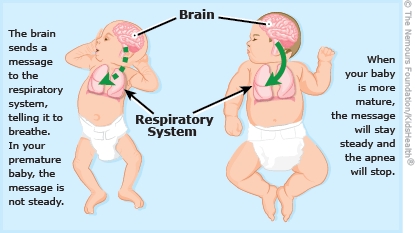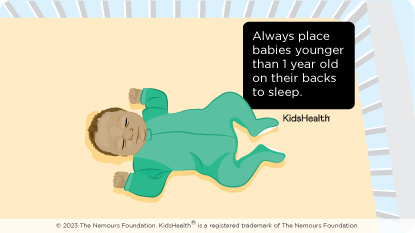Apnea of prematurity (AOP) is when a premature baby (a baby born early) has:
Your baby had AOP while in the hospital. AOP gets better as a baby grows, so you can care for your baby at home. After AOP goes away, it usually doesn't come back.


At home, if your baby isn't breathing or your baby's face looks pale or bluish:
AOP does not cause SIDS (sudden infant death syndrome), but premature babies have a higher risk for SIDS. To help protect your baby, follow these safe sleep practices:
Make sure everyone who cares for your baby follows these safe sleep practices. Also, don't let anyone smoke around your baby.


Your baby has:

Your baby seems ill after recovering from an apnea spell.
If your baby has an apnea spell and does not start breathing when you try gentle stimulation techniques, start CPR and call 911 right away.

What causes AOP? AOP is caused by an immature breathing system. It happens when a baby doesn't get a regular signal from the brain to breathe or doesn't respond to the signal well. AOP also can happen if a baby's airway has low muscle tone and doesn't stay completely open.
When does AOP stop? It depends on how early the baby was born. For babies born after 28 weeks gestation, AOP usually goes away a few weeks before their original due date. For babies born before 28 weeks gestation, AOP usually goes away a few weeks after their original due date.
How do AOP and periodic breathing differ? Periodic breathing is a pause in breathing that lasts just a few seconds, followed by several fast and shallow breaths. Periodic breathing doesn't cause a change in facial color (such as blueness around the mouth) or a drop in heart rate. A baby who has periodic breathing starts regular breathing again on their own. You do not need to do anything if your baby has periodic breathing. While it can be scary to see, periodic breathing usually causes no other problems.